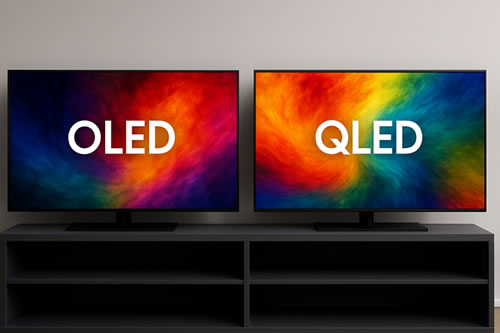OLED vs QLED: Which LED Display is Right for Your Space?

When it comes to choosing the right LED display, two technologies dominate the market – OLED and QLED. While both deliver stunning visuals, they cater to different environments and needs. If you’re considering an upgrade for your business, event space, or digital signage, understanding the key differences between OLED and QLED will help you make an informed decision. Let us explain the key differences… What is OLED? OLED (Organic Light-Emitting Diode) displays use self-emissive pixels, meaning each pixel generates its own light. This means that OLED provides: Perfect blacks – Since each pixel can turn off completely, OLED delivers unparalleled contrast. Vibrant colours – Wide colour accuracy makes images appear more natural. Ultra-thin design – Without the need for a backlight, OLED screens are slimmer and more flexible. Fast response times – Ideal for content with lots of motion, reducing blur. What environments are best for OLED? – High-end corporate settings – Where premium visuals and modern design matter. – Dark environments – Such as control rooms, home cinemas, or high-end retail stores. – Creative installations – Where flexibility and curved displays are needed. What is QLED? QLED (Quantum Dot Light-Emitting Diode) is an enhanced version of LED that uses a quantum dot layer to improve brightness and colour accuracy. Unlike OLED, it relies on a backlight, which means: Superior brightness – QLED displays typically offer superior brightness levels and a wider colour gamut compared to many other display technologies. Perfect for well-lit spaces. No risk of burn-in – Ideal for static images like signage. This makes QLED a more robust option for commercial or long-term usage, such as digital signage or control rooms More affordable for larger screens – Generally, QLED is more cost-effective in bigger sizes. Longer lifespan – Since there’s no organic material, QLED screens typically last longer. What environments are best for QLED? – Bright office spaces – Where natural and artificial light can impact visibility. – Digital signage – Ideal for retail, transport hubs and advertising displays. – Sports bars and public viewing areas – High brightness ensures a clear image, even in daylight. Which One Should You Choose? If you need unmatched contrast and colour accuracy, OLED is the way to go. However, if you prioritise brightness and durability, QLED is the better option. Still unsure? Our team can help you find the right LED display for your specific requirements. Get in touch today and let’s discuss the best solution for your space!
